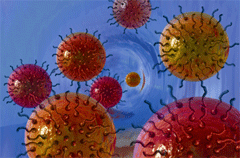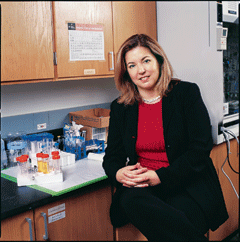Is Small Beautiful?
Air Date: Week of June 8, 2007

(Courtesy of Vicki Colvin)
Nanotechnology, the manipulation of matter on the atomic level, is in products from sunscreen to washing machines, but the government has no specific regulations for this emerging field. Living on Earth host Bruce Gellerman talks with Dr. Vicki Colvin, director of the Center for Biological and Environmental Nanotechnology at Rice University, to learn more about why size matters when it comes to nanoparticles.
Transcript
GELLERMAN: There are a lot of big environmental stories…today we’re considering small things, very small things.
Nanotechnology. The US Commerce Department calls nanotech the next industrial revolution. Nanotechnology is the manipulation of matter at the atomic level and using the knowledge to manufacture products and develop industrial processes. The industry is relatively small right now but it’s growing fast. In just a little over a year, the number of nanotech products on the market has doubled to nearly 500. You’ll find nanotech used in skin creams, washing machines, bed-sheets and bowling balls. Nanotech has arrived. The question is are we ready for it?
Joining me from Zurich Switzerland is Professor Vicki Colvin, executive director of ICON – The International Council on Nanotechnology and head of the Center for Biological and Environmental Nanotechnology at Rice University. Professor, welcome.
COLVIN: Thanks for having me on the show.
GELLERMAN: So, I had no idea nanotech was in so many things.
COLVIN: Yeah, it’s kind of amazing because I think when this all started it was supposed to be the next big thing and we didn’t know it’s the actual thing. It’s here and we use it and it makes our lives better in some interesting ways.

Professor Vicki Colvin is the Director of the Center for Biological and Environmental Nanotechnology at Rice University (Courtesy of Rice University Department of Media Relations)
COLVIN: Well, I’d say one product that I’m happy to use is anti-microbial toys actually that have a coating on them that resists the development of bacteria that can be damaging to my kids. So to me that’s a great trade off because anybody who has kids knows when they get sick they are pretty pitiful. If you can avoid that outcome I think that’s a great thing. So, that’s one example and another of course is sunscreens which I also use because I live in a warm climate with lots of sun. So, those are two products that I think nanaotech’s benefits are clear.
GELLERMAN: Do any of the nanotech products give you the willies?
COLVIN: Yeah, they do. You know I study, that’s part of what we think about at Rice is the sort of the good side and the other side, which is nothing great comes without its cost. You gotta think that through. So, there’s some sunscreens on the market that they have different types of nano-materials in them. I’ve thought long and hard about it. There’s a particular type that I use. I like the type that has zinc oxide in it because zinc is always good for you. It’s hard to make it not good for you even when it’s nano. And the other option is one that has titanium dioxide. And that’s just a little bit more uncertain for my tastes. It’s a personal call.
GELLERMAN: But is it the product, or the chemical, or the size that matters?
COLVIN: It is an interesting question. You know I’m a chemist, right so it all boils down to what is it? What’s the composition? What’s the stuff? Is it gold, is it carbon? So that matters. But, you know size is a very powerful parameter. I mean you can wear a silver ring and it looks silver. But if you made that same silver nano-sized you could eat it and turn yourself blue. So things are really different when they’re small. They do different stuff. And particularly in biological systems like us they can have a lot more transport, get into nooks and crannies that larger materials can’t. That’s their origin of their great power in medicine. And it’s also the thing that can give you the willies.
GELLERMAN: I think the issue is do we have federal regulations in place that can keep up with this technology.
COLVIN: Yeah, you know that’s a challenge for regulatory agencies. I mean, we all want really rapid technology. We want it to make our lives better and in large part it has. And I think that regulatory agencies have to invest in looking at new technologies and really trying to get ahead of the curve instead of behind the curve and thinking about them. And I honestly don’t know if the oversight is good enough because we actually can’t see the future yet. Certainly they’ve been cautious in regulating it. I wouldn’t say they’ve been over protective. And that means that a lot of economies and businesses have been able to develop. But the question that all of us have is you know we really hope that businesses that are profiting from these products, that they have taken to heart the great responsibility that I think they hold. If they’re profiting from this new technology that’s ahead of the curve in regulation they gotta get it right.
GELLERMAN: There are no specific nanotech laws on the books.
COLVIN: No, there are not and there’s a lot of debate in our agencies about do they need to have specific nanotech laws. I think that strikes fear in the hearts of many many people. Because nanotech while it’s new at the end of the day it’s chemicals, it’s materials. Things we, you know, we know how to think about them and evaluate their risks. I think that the challenge is that some of our assumptions about how materials interact with us, as biological systems have to be a little different when it’s small. And certainly if we built a whole big gigantic research program in this country and globally in the fact that nanotech is new and different and the materials offer us really special properties, probably some of those properties could translate into biological or environmental properties. So that’s why things like labeling become really important because then consumers, people, can make their own decisions. Because I kind of want to know, what risks am I taking. And if they’re unknown I want to know that too.

Many nanoparticles act like magnets on a miniature scale, and are the basis for developing point-of-use water purification systems in arsenic-rich areas of the world. (Courtesy of Vicki Colvin)
COLVIN: Well, Swiss Re is a fascinating company that is very forward thinking in engaging all kinds of different stakeholders in you know the general public, government, scientists like myself, other industry in conversations about risk. So, Swiss Re has been one of the cutting edge companies in understanding that you don’t want an “us vs. them” mentality. You really want to understand and create high-quality technical data. And you need to do that not just with scientists, but actually with everybody in the room. And that’s actually affected some of the research I’ve done. You know just listening to for example a woman talk about how she doesn’t want to take any risks when she uses her mascara has made me realize, “Hey, I want to know what’s in products!” I want to do the chemistry or the analytical chemistry to figure out what is in these systems and why does it work the way it does. So, Swiss Re’s focus I think is not on a particular issue. I don’t think they’re worried but I think it’s just in engaging and making sure people are talking.
GELLERMAN: Well, professor Colvin, it’s been a pleasure. Thank you very much.
COLVIN: Thank you so much.
MUSIC: Fan Modine “Mesopotamian Pop Soda” from ‘Slow Road To Tiny Empire’ (Slow River Records - 1998)
GELLERMAN: Dr. Vicki Colvin is the director of Center for Biological and Environmental Nanotechnology at Rice University. To consider more small things and hear an interview with nano-scientist Andrew Maynard of the Woodrow Wilson Center, go to our website LOE dot org.
Links
Living on Earth wants to hear from you!
Living on Earth
62 Calef Highway, Suite 212
Lee, NH 03861
Telephone: 617-287-4121
E-mail: comments@loe.org
Newsletter [Click here]
Donate to Living on Earth!
Living on Earth is an independent media program and relies entirely on contributions from listeners and institutions supporting public service. Please donate now to preserve an independent environmental voice.
NewsletterLiving on Earth offers a weekly delivery of the show's rundown to your mailbox. Sign up for our newsletter today!
 Sailors For The Sea: Be the change you want to sea.
Sailors For The Sea: Be the change you want to sea.
 The Grantham Foundation for the Protection of the Environment: Committed to protecting and improving the health of the global environment.
The Grantham Foundation for the Protection of the Environment: Committed to protecting and improving the health of the global environment.
 Contribute to Living on Earth and receive, as our gift to you, an archival print of one of Mark Seth Lender's extraordinary wildlife photographs. Follow the link to see Mark's current collection of photographs.
Contribute to Living on Earth and receive, as our gift to you, an archival print of one of Mark Seth Lender's extraordinary wildlife photographs. Follow the link to see Mark's current collection of photographs.
 Buy a signed copy of Mark Seth Lender's book Smeagull the Seagull & support Living on Earth
Buy a signed copy of Mark Seth Lender's book Smeagull the Seagull & support Living on Earth

